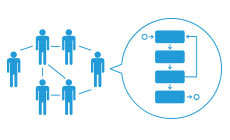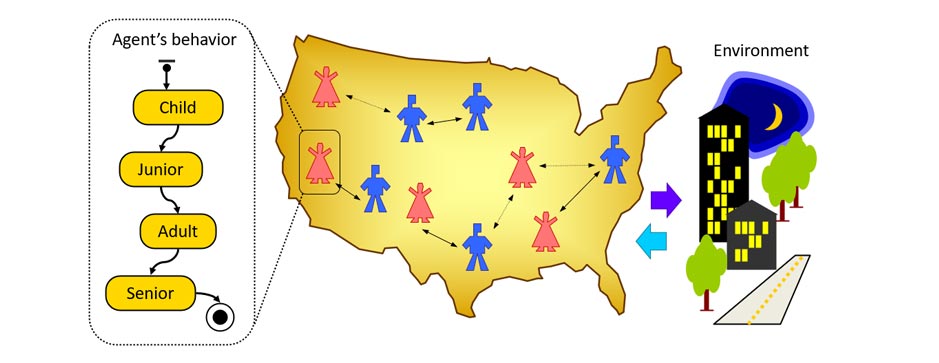Introduction of Agent-based Modeling
We live in an increasingly complex world where its complexities are on the rise, and the systems we need to analyze and model become more and more interdependent. Traditional modeling tools have long ceased to be responsive to these needs, and the demand for modern modeling and simulation tools such as agent-based modeling, agent-centric modeling, agent-oriented modeling, or agent-based simulation is more evident than ever.
Agent-based modeling is a powerful simulation approach that has proven to be an effective solution for real-world problems in recent years. Due to its bottom-up perspective, agent-based simulation is highly flexible. To simulate a system using agent-based modeling, the first step involves identifying the agents within the system. Subsequently, by specifying their behaviors, interactions, and influence dynamics, the overall behavior of the system is extracted.
Agent Definition
As the name implies, Agent-Based Modeling (ABM) is based on the concept of agents. Also known as agent-centric modeling or agent-oriented modeling, this modeling approach revolves around agents. There are various discussions and debates about defining agents. The only general consensus is that the central and acceptable concept for all is the autonomy of the agent. There are two distinct definitions of agents:
- An agent is a computer system placed in an environment with the ability to independently interact with the environment to achieve embedded goals. Stating that agents are computer entities means they exist in the form of programs that run on computational systems.
- Anything that can perceive its environment through sensors, and independently interact with that environment through actuators, is referred to as an agent.

Agent Characteristics
In the Agent-Based Modeling (ABM) approach, defining agents and their characteristics is of significant importance. As mentioned in the definition of agents, independence is one of the most crucial features of an agent. Other characteristics of an agent include having memory, interactiveness, the ability to influence and be influenced, and existing within an environment.
Additionally, other features such as intelligence, decision-making capabilities, and more are discussed in various articles. However, these are not explicitly mentioned as primary characteristics of an agent since their necessity depends on specific scenarios and contexts.
Agent-based Modeling Tools
So far, several tools have been developed for agent-based modeling, and they can be utilized for agent-based simulation:
- AnyLogic
- NetLogo
- Repast
- JADE
The most advanced software for agent-based modeling is AnyLogic. In contrast to other tools, AnyLogic has a graphical environment, allowing the use of designed components in the software environment to build agent-based simulation models. Additionally, the amount of coding in AnyLogic is significantly less than similar software like NetLogo. Having a suitable graphical interface is essential for agent-based modeling, and AnyLogic provides this capability for building agent-based simulation models.
Appropriate Modeling and Simulation Approach
The question that most modelers often face is the choice of an appropriate modeling and simulation approach. Given the existence of three simulation approaches, it is beneficial to become familiar with the role of agent-based modeling.
The discrete event simulation approach is suitable for problems where the modeler is interested in a high level of detail. The system dynamics modeling approach is appropriate for issues presented at a strategic level where the focus is on low-level details. However, the agent-based modeling approach, due to its bottom-up approach as explained earlier, offers a high level of flexibility. Due to this flexibility, a wide range of problems, from strategic to operational levels with varying levels of detail, can be modeled using the agent-based or agent-centered modeling approach.
It is essential to note that the time required to build a problem using the agent-based approach is generally more than modeling the same problem with the two traditional approaches, discrete event simulation, and system dynamics. Additionally, the agent-based modeling approach requires more hardware resources (computational and memory) compared to other traditional approaches. Therefore, if a problem can be effectively modeled using traditional approaches, it is better to use them. However, some problems cannot be modeled effectively using either of the two traditional simulation approaches. In such cases, the best approach for simulation and modeling is to use agent-based modeling or agent-based simulation.

AnyLogic as Agent-based Modeling Software
“As mentioned, AnyLogic is the top simulation tool that has provided the capability to create computer simulation models. This software supports both discrete event simulation and agent-based simulation approaches, allowing the creation of computer simulation models with varying complexities and dimensions.
If you are interested in learning how to build computer simulation models using AnyLogic, it is recommended to participate in the training courses provided by Shabihpardazan Co,.”



